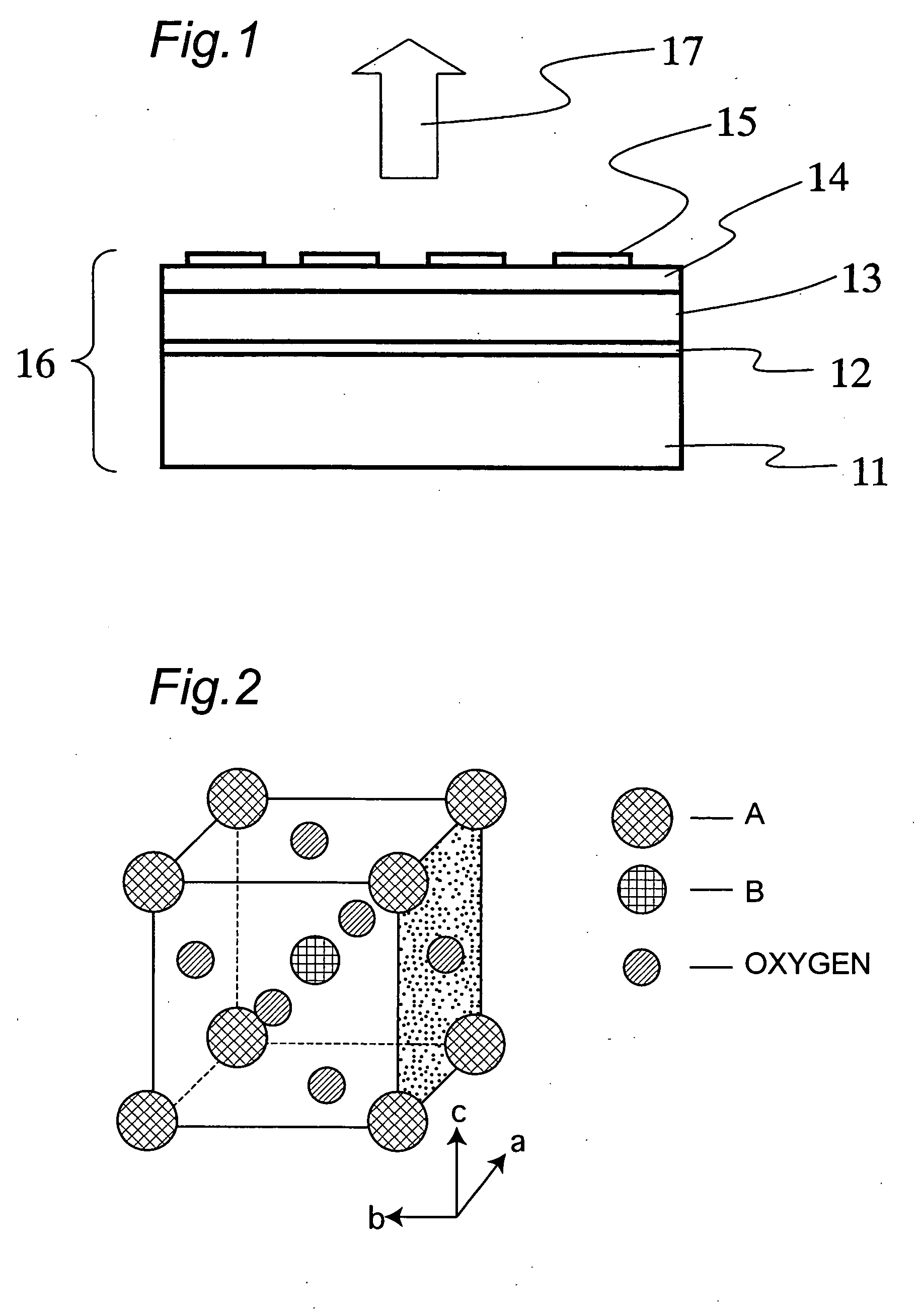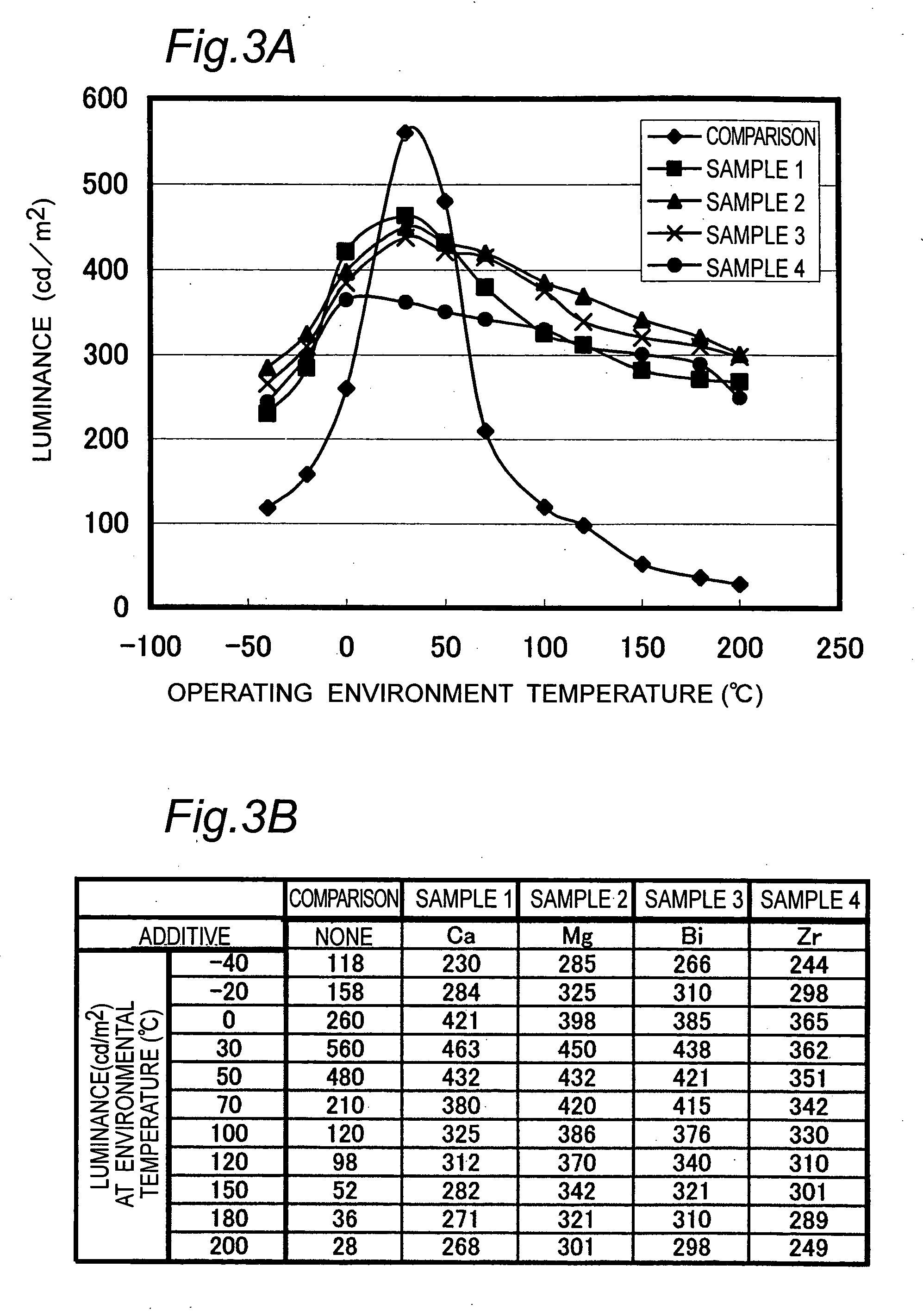Light-emitting device and display device
a technology of light-emitting devices and display devices, which is applied in the direction of discharge tubes/lamp details, discharge tubes luminescnet screens, electric discharge lamps, etc., can solve the problems of inability to increase the output luminance, and low dielectric strength of the dielectric layer, so as to reduce the cost, increase the luminance, and the effect of high luminan
- Summary
- Abstract
- Description
- Claims
- Application Information
AI Technical Summary
Benefits of technology
Problems solved by technology
Method used
Image
Examples
embodiment 1
[0033]FIG. 1 is a section view of an EL device according to a first embodiment of the present invention. Sequentially layered on a base substrate 11, this EL device 16 has back electrodes 12 that are the first electrodes in a striped pattern, a dielectric layer 13 formed by thin film deposition of a dielectric material, an phosphor layer 14 made from an inorganic phosphor, and transparent front electrodes 15 that are the second electrodes in a striped pattern. The back electrodes 12 and front electrodes 15 are striped in mutually perpendicular directions. When a voltage is applied between the back electrodes 12 and front electrodes 15, light 17 emitted from the back electrodes 12 at the intersecting portion of the selected back electrodes 12 and the selected front electrodes 15 is emitted passing through the front electrodes 15.
[0034] The components of this EL device 16 are further described below.
[0035] The substrate 11 could be a ceramic substrate, a plastic substrate subjected ...
embodiment 2
[0085]FIG. 10 is a section view of an EL device 102 according to a second embodiment of the present invention. This EL device 102 differs from the EL device in the first embodiment only in having a buffer layer 101 rendered between the back electrodes 12 and dielectric layer 13. Note that like parts here and in FIG. 1 are identified by like reference numerals.
[0086] The composition of the buffer layer 101 is described by the chemical formula MgxSi1-xO (where 0.913 over a buffer layer 101 of this composition affords good crystal characteristics and crystal orientation characteristics in the dielectric. Compositions outside the ranges of this chemical formula disturb the crystal structure of the NaCl structure or the face-centered cubic structure (fcc structure) that is the basic structure of MgO, thus degrade the crystal orientation, and are therefore undesirable.
[0087] Table 3 shows the results of tests exploring the relationship between the film thickness of the buffer layer 101 ...
embodiment 3
[0088]FIG. 11 is a section view of an EL device 112 according to a third embodiment of the present invention. Compared with the EL devices of the first and second embodiments, this EL device 112 is the same as the EL devices shown in FIG. 1 and FIG. 10 except that a bottom layer 111 is rendered between the substrate 11 and the back electrodes 12 made of a conductor containing one of Pt, Pd, Au, Ir, Rh, and Ni.
[0089] The bottom layer 111 is a 5 nm to 50 nm thick film of Ti, Co, or Ni. Rendering this bottom layer 111 improves adhesion between the substrate 11 and back electrodes 12.
PUM
 Login to View More
Login to View More Abstract
Description
Claims
Application Information
 Login to View More
Login to View More - R&D
- Intellectual Property
- Life Sciences
- Materials
- Tech Scout
- Unparalleled Data Quality
- Higher Quality Content
- 60% Fewer Hallucinations
Browse by: Latest US Patents, China's latest patents, Technical Efficacy Thesaurus, Application Domain, Technology Topic, Popular Technical Reports.
© 2025 PatSnap. All rights reserved.Legal|Privacy policy|Modern Slavery Act Transparency Statement|Sitemap|About US| Contact US: help@patsnap.com



